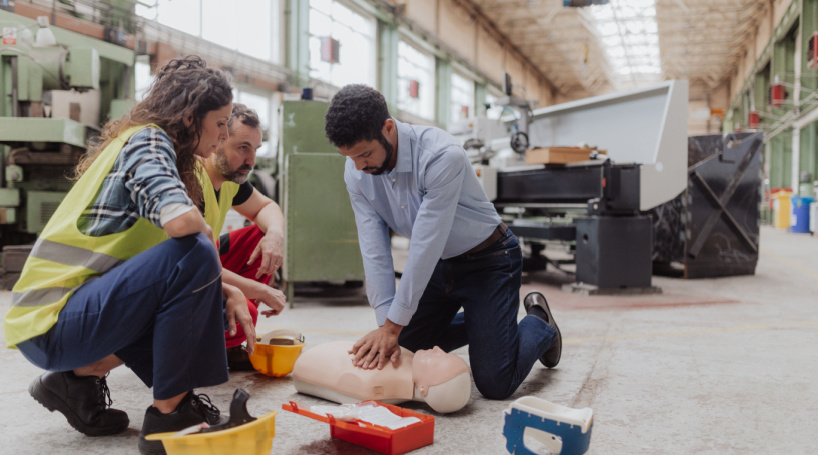The importance of ergonomics in the workplace cannot be overstated. Ergonomics is the science of designing and arranging workplaces, products, and systems so that they fit the people who use them. A well-executed ergonomic assessment can improve employee comfort, safety, and productivity while reducing the risk of workplace injuries.
Safety courses play a pivotal role in enhancing the effectiveness of ergonomic assessments within the workplace. These courses provide employees with essential knowledge and skills related to identifying potential hazards, understanding proper ergonomics, and implementing safety protocols. Ultimately, the integration of safety courses into the ergonomic assessment process not only reduces the risk of workplace injuries but also fosters a safer and more comfortable work environment for all.
Why is Ergonomic Assessment Important?
Ergonomic assessments are crucial because they help organizations identify and mitigate workplace hazards, thereby enhancing employee well-being and performance. The benefits of conducting an ergonomic assessment include:
- Reduced Workplace Injuries - Proper ergonomics can prevent musculoskeletal disorders (MSDs) and other work-related injuries, such as strains, sprains, and repetitive stress injuries.
- Enhanced Productivity - Employees who work in ergonomic environments are more comfortable and less fatigued, leading to increased productivity and job satisfaction.
- Cost Savings - Fewer workplace injuries mean reduced workers' compensation claims and lower healthcare costs for the organization.
- Compliance - Ergonomic assessments help companies comply with workplace safety regulations, reducing the risk of fines and legal issues.
- Employee Retention - Creating a comfortable and safe work environment can attract and retain talented employees.
How to Perform an Ergonomic Assessment
Identify Goals and Objectives
In the initial phase of performing an ergonomic assessment, it's important to lay out clear goals and objectives. First, determining the scope of the assessment sets the boundaries for the evaluation. This step helps focus efforts on the areas that need attention the most. Secondly, defining specific goals is essential – whether it's about reducing employee discomfort, preventing particular injuries, or addressing other ergonomic concerns.
Gather Information
This includes a thorough understanding of the tasks performed by employees, the configuration of their workstations, and the equipment they use. Additionally, reviewing incident reports and injury data is pivotal in identifying patterns and pinpointing specific areas with recurring issues.
Select Assessment Tools
Selecting the right assessment tools is similar to choosing the right instruments for a precise diagnosis. It involves picking suitable methods such as checklists, questionnaires, and measurement devices that are tailored to gather the necessary data effectively.
Assemble a Team
No ergonomic assessment is complete without the collaborative efforts of a well-constituted team. This team should ideally comprise representatives from various sectors, including management, health and safety experts, and, notably, employees who are directly engaged in the tasks being assessed. This diverse team brings different perspectives to the table.
Conduct Workplace Observations
Hands-on observation is a cornerstone of an ergonomic assessment. While observing employees as they go about their tasks, it is imperative to pay close attention to key factors such as posture, repetitive movements, and any signs of discomfort or strain.
Collect Employee Feedback
Employee experiences and insights are invaluable in understanding the ergonomic dynamics at play. Conducting interviews with employees provides a platform for them to voice concerns and encourages reporting discomfort or pain, which might otherwise go unnoticed.
Assess Workstations and Equipment
The assessment moves on to evaluating the design and arrangement of workstations, chairs, computer equipment, and other tools. Ensuring that these elements are adjustable and well-maintained is crucial for optimizing ergonomic conditions.
Review Work Processes
Examining work processes is another critical aspect of ergonomic assessment. It involves scrutinizing tasks for potential opportunities to reduce repetitive activities or heavy lifting. Considering automation or workflow adjustments can significantly enhance ergonomic conditions.
Recommend Improvements
Armed with the data and observations, the next step is to develop a comprehensive list of recommendations to enhance ergonomics in the workplace. These recommendations should be prioritized based on their potential impact and feasibility.
Implement Changes
The implementation phase involves working closely with management to put the recommended ergonomic improvements into practice. This often includes providing training to employees on proper ergonomic practices to ensure that the changes are effectively integrated.
Monitor and Evaluate
Ergonomic improvements should not be a one-time endeavour. Continuous monitoring is essential to gauge the effectiveness of the changes made. Soliciting feedback from employees is invaluable in assessing whether the alterations have indeed positively impacted their comfort and productivity.
Documentation
Maintaining thorough records of the entire assessment process, including findings, recommendations, and actions taken, is crucial. This documentation not only helps in tracking progress but also serves as a valuable reference for future assessments and improvements.
Final Thoughts
A well-executed ergonomic assessment is a proactive approach to improving workplace safety, comfort, and productivity. By identifying and addressing ergonomic issues, organizations can create a healthier and more efficient work environment for their employees. Remember that ergonomics is an ongoing process, and regular assessments can help ensure that your workplace remains safe and comfortable for all employees.
Investing in ergonomics and safety courses is not just a legal requirement; it's a smart business decision that can lead to happier, healthier, and more productive employees.

